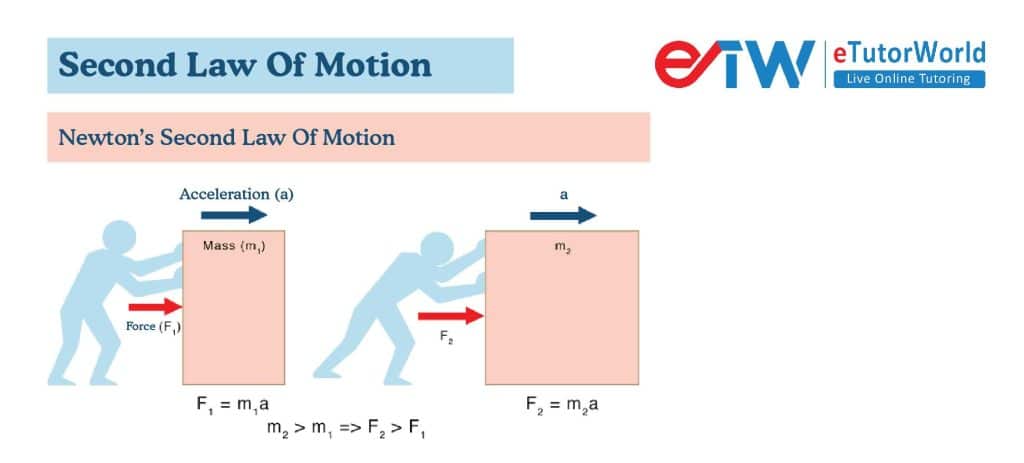Second Law Of Motion
Grade 6 Science Worksheets
The second law of motion, also known as the law of force and acceleration, states that the net force acting on an object is proportional to its mass and acceleration.
Second Law Of Motion - Grade 6 Science Worksheet PDF
This is a free printable / downloadable PDF worksheet with practice problems and answers. You can also work on it online.
|
|
Untimed |
|
Sign up with your email ID to access this free worksheet.
"We really love eTutorWorld!"
"We really love etutorworld!. Anand S and Pooja are excellent math teachers and are quick to respond with requests to tutor on any math topic!" - Kieran Y (via TrustSpot.io)
"My daughter gets distracted easily"
"My daughter gets distracted very easily and Ms. Medini and other teachers were patient with her and redirected her back to the courses.
With the help of Etutorworld, my daughter has been now selected in the Gifted and Talented Program for the school district"
- Nivea Sharma (via TrustSpot.io)
What is Newton’s Second Law Of Motion?
The second law of motion, also known as the law of force and acceleration, states that the net force acting on an object is proportional to its mass and acceleration. This law can be expressed mathematically as:
F_net = ma
where F_net is the net force acting on the object, m is the mass of the object, and a is the acceleration of the object.

In other words, the greater the force applied to an object, the greater its acceleration, and the greater its mass, the smaller its acceleration for a given force.
When there are unbalanced forces acting on an object, Newton’s second law of motion applies. According to the second law, the mass of the object and the net force acting on it affect how quickly an object accelerates.
An object’s acceleration is directly proportional to the net force acting on it and inversely proportional to its mass. An object’s acceleration increases as the amount of force acting on it does. A decreasing acceleration is caused by an increase in an object’s mass.
Here are a few examples of the second law of motion:
1. A car accelerates more quickly when the driver presses harder on the gas pedal. The greater force applied to the car’s engine produces a greater acceleration.
2. A person is more likely to slip and fall on an icy sidewalk than on a dry one. The force of friction between the person’s shoes and the ground is smaller on the icy surface, which results in greater acceleration for a given mass.
3. A heavier object requires more force to accelerate than a lighter object. For example, it takes more force to accelerate a fully loaded truck than a small car, even if they have the same engine power.
4. When a person jumps off a diving board, the force of gravity accelerates them downward. As the person falls, their speed increases, and they experience a greater force of air resistance, which opposes the force of gravity and slows down their acceleration.
These examples demonstrate how the second law of motion applies to different situations and helps us understand the relationships between force, mass, and acceleration.
“There have been times when we booked them last minute, but the teachers have been extremely well-prepared and the help desk at etutorworld is very prompt.
Our kid is doing much better with a higher score.”
6th Grade Tutoring
eTutorWorld offers Personalized Online Tutoring for Math, Science, English, and Standardised Tests.
Our Tutoring Packs start at just under $22.49 per hour, and come with a moneyback guarantee.
Schedule a FREE Trial Session, and experience quality tutoring for yourself. (No credit card required.)
Do You Stack Up Against the Best?
If you have 30 minutes, try our free diagnostics test and assess your skills.
Second Law of Motion FAQS
What is the second law of motion?
The second law of motion states that the acceleration of an object is directly proportional to the force acting on it and inversely proportional to its mass. This law is often expressed as F=ma, where F is the net force acting on an object, m is its mass, and a is its acceleration.
What is the meaning of force in the second law of motion?
In the context of the second law of motion, force is any influence that can cause an object to accelerate, change direction, or deform. Force can be applied through contact (such as a push or a pull) or through fields (such as gravitational or electromagnetic fields).
How is electrical energy converted into other forms of energy?
Electrical energy can be converted into a variety of other forms of energy, including light, heat, mechanical energy, chemical energy, and sound energy, through the use of different devices and processes.
How is electrical energy stored?
Electrical energy can be stored in batteries, capacitors, and other devices that are designed to store electrical charge.
How does the second law of motion relate to everyday life?
The second law of motion is relevant to many everyday situations, such as pushing a shopping cart, throwing a ball, or riding a bicycle. In each of these situations, the force applied to an object (such as the cart, the ball, or the bike) determines how quickly it accelerates and how much resistance it encounters due to its mass.
What is an example of the second law of motion in action?
One example of the second law of motion in action is a rocket taking off. The engines of a rocket provide a force that propels it forward, while the mass of the rocket determines how much acceleration can be achieved for a given amount of force.
How does the second law of motion apply to Newton's cradle?
Newton’s cradle is a device that demonstrates the principle of conservation of momentum, which is related to the second law of motion. When one ball in the cradle is released, it transfers momentum to the next ball, which then transfers momentum to the next ball, and so on, until the momentum is dissipated due to friction and other forces.

Kathleen Currence is one of the founders of eTutorWorld. Previously a middle school principal in Kansas City School District, she has an MA in Education from the University of Dayton, Ohio. She is a prolific writer, and likes to explain Science topics in student-friendly language. LinkedIn Profile
Affordable Tutoring Now Starts at Just $22.49
eTutorWorld offers affordable one-on-one live tutoring over the web for Grades K-12. We are also a leading provider of Test Prep help for Standardized Tests (SCAT, CogAT, MAP, SSAT, SAT, ACT, ISEE, and AP).
What makes eTutorWorld stand apart are: flexibility in lesson scheduling, quality of hand-picked tutors, assignment of tutors based on academic counseling and diagnostic tests of each student, and our 100% money-back guarantee.
Whether you have never tried personalized online tutoring before or are looking for better tutors and flexibility at an affordable price point, schedule a FREE TRIAL Session with us today.
*There is no purchase obligation or credit card requirement
Grade 6 Science Worksheets
- Inquiry process
- Nature of Science
- Scientific Inquiry
- Inquiry, Analysis and Problem Solving
- Ethical Practices
- Science and Society
- Biotic and Abiotic Factors
- Impact of Organisms
- Adaptation
- Spheres of Earth
- Natural Resources
- Environmental Issues
- Conservation of Earth
- Understanding Technology
- Abilities To Do Technological Design
- Structure of Earth
- Solar System
- Rocks and Fossils
- Earth Systems
- Plate Tectonics
- Evolution
- Magnetic Field of Earth
- Geologic Time
- Materials and Processes That Shape a Planet
- Astronomy
- Ecology
- Energy
- Kinetic and Potential Energy
- Energy Transfer
- Matter and its Structure
- States of Matter
- Physical and Chemical Changes
- Force and Motion
- Electricity and Magnetism
- Wave Interactions
- Sound
- Light
- Introduction to Life Science
- The Origin & History of Life On Earth
- Plant and Animal Cells
- Parts of a Cell
- The Cell Cycle
- How Living Organisms Get Energy
- Classification of Organisms
- How Plants Grow & Reproduce
- The Human Respiratory System
- The Human Cardiovascular System
- The Human Digestive System
- The Human Endocrine Systems
- The Human Nervous System
- The Human Muscular System
- The Human Skeletal System
IN THE NEWS

Our mission is to provide high quality online tutoring services, using state of the art Internet technology, to school students worldwide.
Online test prep and practice
SCAT
SSAT
ISEE
PSAT
SAT
ACT
AP Exam
Science Tutoring
Physics Tutoring
Chemistry Tutoring
Biology Tutoring
Math Tutoring
Pre-Algebra Tutoring
Algebra Tutoring
Pre Calculus Tutoring
Calculus Tutoring
Geometry Tutoring
Trigonometry Tutoring
Statistics Tutoring
Quick links
Free Worksheets
Fact sheet
Sales Partner Opportunities
Parents
Passive Fundraising
Virtual Fundraising
Our Expert Tutors
Safe and Secure Tutoring
Interactive Online Tutoring
After School Tutoring
Elementary School Tutoring
Middle School Tutoring
High School Tutoring
Home Work Help
Math Tutors New York City
Press
©2022 eTutorWorld Terms of use Privacy Policy Site by Little Red Bird
©2022 eTutorWorld
Terms of use
Privacy Policy
Site by Little Red Bird










